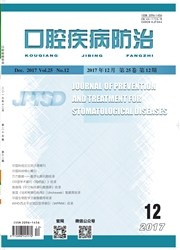

 中文摘要:
中文摘要:
目的比较在正畸力作用下经牙囊细胞(dental follicle cells,DFCs)与牙周膜干细胞(periodontal ligament stem cell,PDLSCs)复合细胞膜片诱导再生的牙周组织与正常牙周组织中牙齿移动速率的差异,探讨对再生组织实施正畸牙移动的可行性。方法选择6只成年雄性比格犬,拔除上下颌双侧第一前磨牙。左上及右下象限为实验组,于拔牙窝远中制造4 mm×4 mm×4 mm骨缺损,移植DFCs/PDLSCs复合细胞膜片修复牙周组织缺损,诱导其重建;左下及右上象限为对照组。移植术后12周,安装正畸加力装置,以尖牙为支抗近中牵引第二前磨牙,力值150 g,牵引4周后测量实验组、对照组第二前磨牙近中移动速率,进行统计学分析。结果 DFCs/PDLSCs复合细胞膜片修复牙周组织缺损形成典型的"牙槽骨—牙周膜—牙骨质"样结构,具有良好的组织学特点,实验组与对照组第二前磨牙近中移动速率差异无统计学意义(P〉0.05)。结论经复合干细胞膜片修复后的牙周组织对于正畸力刺激有良好反应,正畸牙齿移动速率与正常组织无明显差异。
 英文摘要:
英文摘要:
Objective To discuss the feasibility of orthodontic treatment for regenerated periodontal tissues by comparing the difference of tooth movement under orthodontic forces between the normal periodontal tissues and the reconstructed periodontal tissues by the composite cell sheets of dental follicle cells(DFCs) and periodontal ligament stem cells(PDLSCs). Methods Six adult male beagles were selected for experiment animals. The first premolar in all four quadrants of each beagle were extracted and a bone defect were made in the same size(4 mm × 4 mm × 4 mm) distal to the extraction sockets. The upper left and the lower right quadrants were divided into the regeneration group by transplantation of the composite cell sheets while the upper right and lower left quadrants were control group without transplantation. 12 weeks after transplantation, the orthodontic forces were introduced to move the second premolar mesially with a force value 150 g. Measurements were done after 4 weeks of traction to record the movement of the tooth. And compare the difference between the regeneration group and control group by the statistical analysis. Results DFCs/PDLSCs composite cell sheets repaired the periodontaltissue and formed the typical alveolar bone-periodontal membranecementum structurewhich shows good histological characteristics. experimental group and control group show no statistical difference in the rate of tooth movement(P 0.05). Conclusion The periodontal tissues regenerated by this kind of the composite cell sheet showed a good response to mechanical stimulation.
 同期刊论文项目
同期刊论文项目
 同项目期刊论文
同项目期刊论文
 期刊信息
期刊信息
